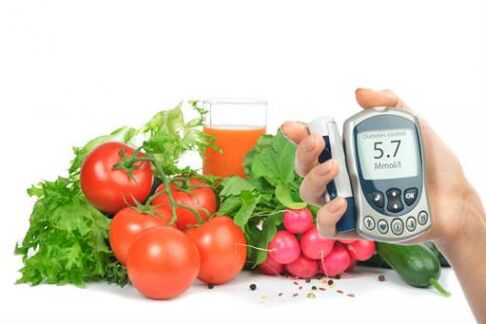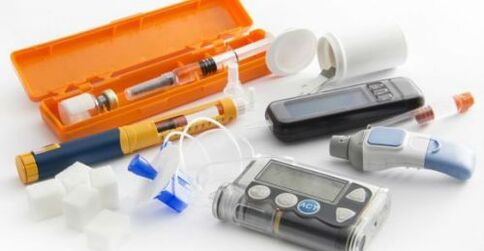Diabetes is a pathological condition characterized by disruption of metabolic processes (metabolism). This is due to insufficient production of the own hormonal substance insulin, as in type 1 diabetes or a violation of its effects on the cells and tissues of the body (type 2 pathology).
The article discusses in detail the main types of diabetes, differences in their etiology and developmental mechanisms, and a description of the treatment characteristics of patients.
A little about insulin and how it works in the body
Insulin is a hormone produced by the pancreas. This organ is located behind the stomach and is surrounded by the spleen and duodenal ring. The pancreas weighs about 80 grams.
In addition to hormones, the glands also produce pancreatic juice, which is necessary for the digestion of lipids, carbohydrates and proteins. The hormone insulin is synthesized by beta cells. They spread over almost the entire surface of the pancreas in small clusters called islets of Langerhans. Islets also contain alpha cells that synthesize the hormonal active substance glucagon. This hormone works in the opposite way to insulin.
A healthy adult human has about a million of these islets, with a total weight of a few grams.
Insulin is a protein molecule composed of several chains of amino acids. Its task is to absorb glucose (sugar) through the cells of the body. Sugar is necessary for people to obtain energy. Without it, cells and tissues cannot cope with their functions.
Along with sugar intake, insulin also regulates the penetration of amino acids into cells. Amino acids are considered to be one of the main building materials. Another function of insulin is the accumulation of lipids in the body.
Classification of diabetes
According to the classification of diabetes generally accepted and used in modern endocrinology, the pathology is divided into the following types:
- Type 1 - insulin-dependent (IDDM);
- Type 2 - non-insulin dependent (NIDDM);
- form of pregnancy;
- specific types of diabetes.
The latter option is a group of pathological conditions whose pathogenesis and developmental causes differ from each other. These include genetic defects at the genetic level in the hormone insulin or insulin-secreting cells, diseases caused by the action of chemicals and drugs, diabetes caused by infectious processes, etc.
All types of diabetes are combined by high blood sugar. This condition manifests as elevated glucose levels in the blood. The confirmation or refutation of the diagnosis of diabetes is based on the background of the diagnosis of blood glucose level.
1 type
Type 1 pathology (ICD-10 code - E10) is thought to be an autoimmune process resulting in the death of insulin-secreting cells. In simple language, such a process is initiated in the human body, during which their own immune cells see pancreatic cells as foreign and destroy them.
Usually, insulin dependence is caused by a genetic predisposition, but accompanying predisposing factors also play an important role. Statistics show that children may have pathology when:
- If the mother is ill - the frequency is 2%;
- Sick father - 5%;
- Sick siblings - 6%.

If one of the relatives has the disease, the rest of the family may be healthy, although they are at high risk.
More than 80% of insulin-dependent patients have an autoimmune process, the body's antibodies against the pancreas' own cells. Often, people with diabetes have other autoimmune diseases, such as chronic adrenal insufficiency, pancreatic disease, vitiligo, rheumatism, along with type 1 disease.
How is it going?
Typically, clinical symptoms of the disease appear when more than 85% of the insulin-secreting cells have died, but the duration of this period may vary depending on the individual characteristics of the organism. Often occurs in childhood and adolescence. It happens that young patients are already aware of the presence of disease during acute complications (eg, in a state of ketoacidosis).
The lack of energy and insulin leads to a massive breakdown of fat and protein, which explains the weight loss in patients. Hyperglycemia can lead to hyperosmolarity, which is manifested by the production of large amounts of urine and the development of symptoms of dehydration. Without enough insulin, the body experiences energy starvation, and as a result oversynthesizes suppressor hormones, those that have the opposite effect of insulin's work.
These hormones include cortisol, glucagon, and growth hormone. Although sugar levels in the blood are already at their peak, they stimulate the formation of glucose in the body.
The massive breakdown of fats leads to an increase in the amount of free fatty acids in the blood. This is the trigger for the formation and accumulation of ketone (acetone) bodies, which becomes the trigger for the ketoacidosis state. If such pathology, dehydration, and pH shift of the blood to acidity continues, the patient may fall into a coma and may even die.
symptom
Type 1 diabetes is characterized by marked symptoms that become more severe over several weeks. Diabetics complain that:
- for the formation of large amounts of urine;
- excessive thirst;
- persistent itching of the skin;
- lose weight.
The presentation of the disease is considered to be very specific, but a differential diagnosis is still required.
Weight loss with normal or increased appetite is one of the symptoms that distinguish type 1 pathology from other types of diabetes. The patient was concerned about severe weakness, he was unable to do his usual work, and was lethargic.
The clinical presentation progressed with symptoms of acetone odor in exhaled air, abdominal pain, nausea and vomiting, and severe dehydration. If the disease presents at a later age (about 40 years old), symptoms are less pronounced and the presence of disease is usually determined during clinical examination.
Type 2
Non-insulin dependent diabetes mellitus (ICD-10 code - E11) is a chronic disease in which high blood sugar levels occur due to insulin resistance. Later, the work of Langerhans' pancreatic beta cells was also disrupted. Along with carbohydrate metabolism, pathology also affects fat metabolism processes.
Genetic susceptibility is one of the main causes of type 2 diabetes. If one of the parents is sick, the child will be sick 40% of the time. However, genetics alone is not enough, provocative factors are:
- high body weight;
- low physical activity;
- High blood pressure;
- high levels of triglycerides in the blood;
- Babies born in the past weighing more than 4 kg;
- have had gestational diabetes in the past;
- Polycystic ovary.
Currently, the number of people with type 2 diabetes is increasing. This pathological form accounts for more than 85% of all clinical cases. Middle-aged and elderly men and women are more affected.
How is it going?
The developmental mechanism is based on the fact that insulin resistance develops, that is, the pancreas produces sufficient amounts of the hormone to transport sugar molecules into cells, but the cells themselves lose their sensitivity to the substance. The result is high blood sugar.
To lower blood sugar levels, the glands begin to reach the limit of their ability. This causes depletion of insulin-secreting cells.
For the second pathological condition, the appearance of ketoacidosis is atypical because even small amounts of hormones are synthesized by the islets of Langerhans.
symptom
The disease usually manifests in patients over the age of 40. In most cases, clinical manifestations are combined with the appearance of pathological body weight, changes in fat metabolism in blood tests. Associated symptoms:
- A slight decrease in performance, but not as pronounced as in the first disease;
- pathological thirst;
- Excretion of large amounts of urine;
- Women may be disturbed by itchy skin in the genital area and perineum;
- The rash appears on the skin and does not heal for a long time;
- Leg discomfort, numbness, and goosebumps.
type of pregnancy
The World Health Organization's classification of diabetes includes the gestational form of the disease (ICD-10 code - O24). This is a typical pregnant woman. 5-7% of patients who give birth to babies have diabetes. The World Health Organization's classification of diabetes and its types includes another name for this pathological type - maternal diabetes.
A disorder is considered preconception if it appears in a woman before pregnancy, during pregnancy. At present, the development mechanism and etiology of the disease are not fully understood. There are data on the role of genetic predisposition. Risk factors may be:
- physical and mental trauma;
- infectious diseases;
- Pancreatic disease;
- The menu contains plenty of carbohydrate-rich foods.

Obstetricians and gynecologists agree that adequate physical activity reduces the risk of developing pathology.
The gestational form can manifest as a manifestation, a vivid clinical presentation, or as a violation of glucose tolerance. Usually, the pathology goes away on its own after the baby is born.
The woman became one of those at high risk of developing non-insulin-dependent diabetes in the next 10-15 years.
During childbirth, a woman's body undergoes certain hormonal-related changes. This is due to the function of the placenta, which secretes the following hormones:
- chorionic gonadotropin;
- progesterone;
- Estrogen;
- corticosteroids, etc.
All of these hormonally active substances contribute to the appearance of insulin resistance. At this stage, the proliferation of insulin-secreting cells and the release of large amounts of insulin into the blood are observed from the pancreas. The emergence of insulin resistance causes a woman's body to actively use metabolites of fat, while sugar is stored to nourish the fetus. The disease develops in the presence of a combination of genetic susceptibility to diabetes and the above factors.
symptom
Pregnancy types of the disease manifest in the same way as other types of diabetes, but with less pronounced symptoms. A woman may not notice these symptoms, associating their occurrence with her "interesting" position. If clinically evident, pregnant women may make the following complaints to the attending physician:
- dry mouth;
- a constant craving for alcohol;
- Excretion of large amounts of urine;
- increased appetite;
- performance degradation and weaknesses;
- Itching and burning in the genital area.
important! Usually, the disease occurs at the end of the second trimester or the beginning of the third trimester.
Effects of pathology on mother and fetus
Chronic hyperglycemia has negative effects on the mother's body and the child itself. Pregnancy can be complicated:
- polyhydramnios;
- late pregnancy;
- Termination of pregnancy at different trimesters;
- Children with a large birth weight (over 4-4. 5 kg).
Babies born to sick mothers have unique appearances. They have broad shoulders, pronounced subcutaneous fat, and round moon-shaped faces. There is marked skin swelling and hirsutism. The most serious complications of the disease are fetal death and neonatal death during fetal development. Usually, this occurs when the pre-pregnancy form of the disease is present.

Children born to sick mothers are heavier than their peers and have distinct physical characteristics.
specific type
We are talking about secondary forms of pathological conditions that develop under the influence of chemicals, drugs, infectious processes and other diseases in the endocrine and exoendocrine fields.
Diabetes can be caused by the following pancreatic diseases and conditions:
- organ inflammation;
- mechanical injury;
- removal of glands;
- tumor;
- cystic fibrosis;
- Pigmented liver cirrhosis, etc.
Among chemicals and drugs, niacin, corticosteroids, interferons, thyroid hormones and diuretics can contribute to the development of the disease. The list also includes opiates, poisons used to exterminate rodents, antidepressants, and drugs used in antiretroviral therapy.
Among the pathogens of infectious diseases, the predisposing factors are rubella virus and cytomegalovirus.
Treatment characteristics
Treatment of the pathological condition is selected individually for each clinical case. The treatment options and methods used depend on the degree of diabetes, its type, the brightness of the clinical situation and the presence of complications. A qualified endocrinologist will tell you how to identify and confirm the presence of a disease. He will guide the following diagnostic methods:
- General blood and urine tests;
- Analysis of glucose from the capillary blood of the fingers when fasting;
- blood biochemistry;
- Urine glucose analysis;
- Glucose tolerance test - a glucose tolerance test is mandatory for all expecting mothers between 22 and 26 weeks of pregnancy;
- Determination of glycosylated hemoglobin index.
Treatment measures include not only medication, but also physical therapy exercises, nutritional corrections, and teaching patients self-control.

Importantly, relatives support the patient's desire to reduce the aggressiveness of the pathological condition and achieve compensation.
self control
People with diabetes should record how they feel, blood sugar, and urine sugar levels, as well as personal menu and physical activity data throughout the day. The totality of these indicators and their accounting is self-controlling. The purpose of such events is not only to control sugar levels, but also to interpret the results, and plan their actions when the numbers fall outside the acceptable range.
In normal health, it is important to measure sugar levels at home and record these indicators at least once a day. Any changes in health will require clarification of blood glucose levels several times a day:
- before each main meal;
- After food has entered the body for a period of time;
- before rest at night;
- In some cases, you may need to take the morning measurement on an empty stomach.
Glucose in urine is also measured at home. This requires the presence of a quick bar. They can be purchased at pharmacies. The presence of sugar in the urine will indicate a blood sugar level above 10 mmol/l because it is this number that is the renal threshold for glucose molecules to penetrate the urine.
More rigorous self-monitoring is required if the patient is traveling, actively participating in sports, or has any comorbidities.
For the daily comfort of people with diabetes, it is necessary to purchase the following personal equipment and equipment:
- Blood glucose meter including lancet, test strips and necessary accessories;
- Express urine strips to measure acetone and sugar levels;
- Tonometer for clarifying blood pressure figures;
- Self-control diary, in which all necessary data will be recorded.
food
Correction of individual nutrition is the basis for the treatment of any type of diabetes. For type 1, changing the personal menu can reduce the load on the pancreas and reduce the amount of carbohydrates supplied to the body. In type 2 diabetes, a low-calorie diet can not only achieve the above goals, but also reduce pathological weight.

Patients are advised to observe Form 9, which may have multiple options (a, b, c).
Patients must strictly adhere to their daily calorie intake. It was calculated individually for each patient based on weight, age, sex, energy expenditure, physical activity, medication used. In the patient's diet, limit the intake of carbohydrates and high-calorie foods. Protein is not only possible, but necessary, and fat should be limited a bit, especially for type 2 pathology.
The patient must understand the bread unit system, the glycemic and insulin index of the product, calories. Features of Nutrition Principles:
- Do not eat more than 8 units of bread in one meal;
- Sweetened liquids (lemonade, sweetened tea, store-bought juices) are prohibited;
- Use sweeteners instead of sugar and homemade compote and juice instead of store-bought juice;
- The number of bread units must be planned in advance, as insulin is administered before the product enters the body;
- Meals should be small but frequent;
- Patients should receive adequate fluids - restriction may be present in renal failure or other complications with edema.
You can read more about fasting and the foods you should eat fearlessly in the table.
| Foods with the highest calorie restriction | allowed products | Permitted amount of alcohol (according to conditions of use - below) |
|---|---|---|
|
|
|
The possibility of drinking is discussed separately. If the diabetes is compensated, there are no complications, and the patient feels normal, it can be taken in small amounts. Beer and sweet cocktails are prohibited.
medical treatement
Treatment of IDDM and gestational forms is based on insulin therapy. This is the process of introducing insulin-based hormone preparations to replace the lack of self in the body. There are several groups of drugs that differ in the duration and speed of action: ultrashort preparations, short-acting, intermediate-acting hormones, and long-acting insulins.
Often, doctors combine two drugs with different durations of action at the same time. This is necessary to create the most physiological conditions for the pancreas.

Medications are administered in automatic mode through insulin syringes, syringe pens, or using an insulin pump.
Type 2 disease requires the use of hypoglycemic tablets. There are mainly biguanides, sulfonylureas, thiazolidinediones, glinides, etc.
Differential diagnosis between types of diabetes should only be made by qualified specialists. He will also help you choose treatment options, the best way to live, and provide advice so patients can get reimbursed as quickly as possible.
























